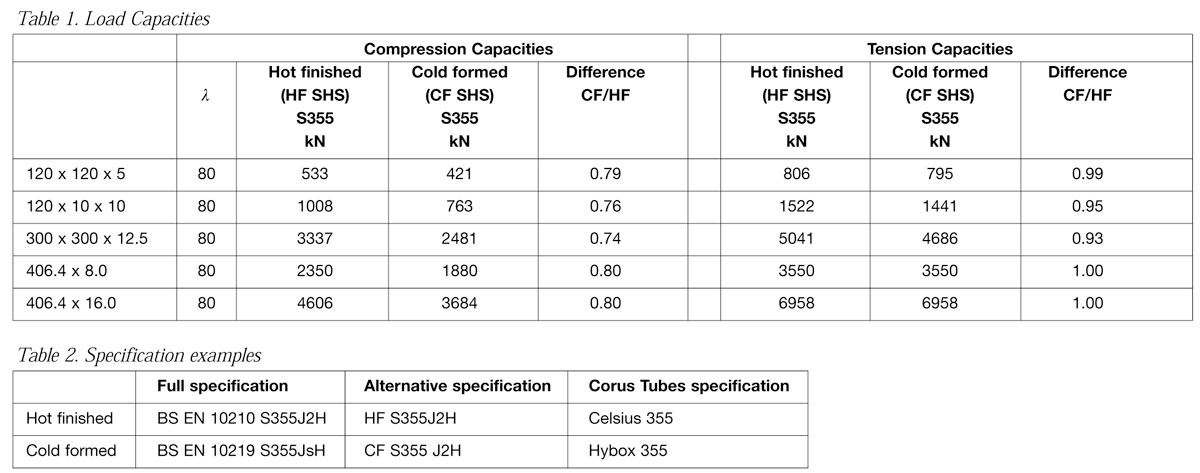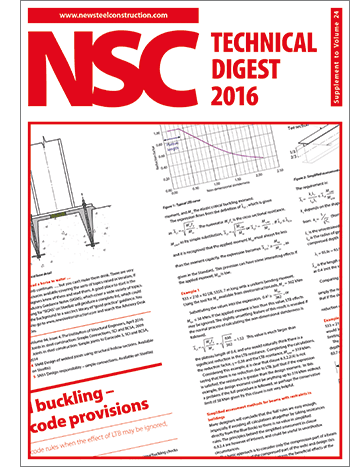Technical
AD 259: Hollow Sections in the Design to Build
Process
Designers need to be aware of the pitfalls that exist when moving through the process from design to build of a structure so as to ensure the final structure is constructed using either the material originally specified at the design stage or material that is equally suitable. Failure to be aware of the pitfalls and take appropriate action can lead to incorrect materials being used and the risk of structural collapse. Fortunately such issues can usually be sorted by basic awareness and ensuring continuity of information through the process.
1. Software defaults
a) Analysis
A substantial amount of analysis and design of structures is now carried out using a range of software packages available on the market. To carry out the analysis and design the package will need to work with member size data and a steel grade. To speed up the design process, most packages, even those that permit free choice by the designer, have some form of default material selection. Generally this default is to the use of hot rolled sections which includes all open profiles of UB’s, UC’s etc and hot finished hollow sections.
Awareness of this default is important as for hollow sections particularly the issue of identification starts at the beginning of the process. Basic section properties vary between the two types of hot finished or cold formed hollow sections, with the latter having lower section properties leading to lower capacities. The user must therefore recognise which type is selected for use in the analysis programme.
b) Design
For the programme to carry out strength checks the user is required to select a steel strength grade, say S355. The packages then either autodesign or check the design of selected section sizes to satisfy both ULS and SLS conditions.
In packages where no option is given to select cold formed hollow sections the programme will default to hot finished and the design checks for compression conditions made using strut curve a. Where an option is available it must be presumed that the correct design process has been adopted and use has been made of the lower strut curve c, together with lower sectional properties.
c) Output
The result is an output of member sizes such as 300 x 300 x 10 S355 and thereby gives the second point of section type awareness. Many programmes do not assign either a full description by standard (e.g. EN 10210) or a partial description reference (e.g. HF) of the default type used. Sometimes reference may be contained somewhere in the input or output files. Indicators of material type is essential as hot finished and cold sections of the same nominal size and thickness can have structural capacities up to 34% difference, with the Cold sections being the lower of the two.
2. Capacity comparison
Structural Hollow Sections are produced by one of two processes. Both section types are included in the latest revision of BS 5950-1: 2000. Hot finished hollow sections are produced in accordance with EN 10210 and as their name implies the final finishing/forming process is hot, in the normalising temperature range. Cold formed hollow sections are produced in accordance with EN 10219 and the final finishing/forming process is at room temperature.
Whilst apparently similar there are basic differences between the section properties, compressive strength and resultant load capacity that makes differentiation of these products, throughout the construction process, very important, not more so because both are available in similar size and thickness ranges and both in a common grade of S355J2H.
Table 1 shows the difference between the two section types. Whilst the difference in tension capacities is small, the difference in compression capacity for the same size, thickness and grade of section can be as low as 0.66 (34% drop).
The designer must be aware of these issues and ensure the full and correct information is passed on into the next stage of the process.
3. Specification requirements
To enable correct purchase and supply the full material requirements must be specified which includes adding the material sub-grade for brittle fracture requirements. This is usually in the form of letters or letters and numbers such as J0 or J2. The requirements are covered by BS 5950-1 clause 2.4.4 and, for hollow sections, Table 5 (of BS 5950-1).
Here the designer must be aware that both hot finished and cold formed structural hollow sections have identical refs e.g. S355J2H and hence the product specification reference must be added e.g. for hot finished: EN 10210 S355J2H. As a reminder and to assist, the data in Table 5 is given in product standard grouping. As before, the designer must ensure this information is carried on through the process.
In addition to strength and brittle fracture requirements BS 5950-2 requires that all steel used in construction must have been subject to specific inspection and test (BS 5950-2 CL. 2.1.3). The engineer must ensure this requirement is clear in the product specification especially as when ordering JR or J0 sub grades this will require the purchaser to implement options in the product specification. In the specific case of Corus Tubes hollow sections the standard product is a J2 quality and is automatically submitted to specific inspection and test and supplied with a 3.1.B test certificate.
An alternative to use of full descriptions is to use a shorter one by reference to the Corus Tubes branded product of Celsius, for hot finished or Hybox for cold formed. These are produced in a standard grade of S355J2H, thereby making it suitable for almost all practical temperature requirements, and are issued with a 3.1.B certificate. Alternative specifications for hot finished and cold formed are shown in Table 2.
4. Substitution
Due to claims of unavailability or price advantage the engineer may be asked to accept a substitution of his initial hot finished section by a cold formed section. Automatic acceptance of any substitution is dangerous and should not be made unless a thorough check has been made. Basic questions:
- Does the section give the same factor of safety? (CF sections have smaller section properties and use a lower strut curve in compression design)
- Is the strength grade satisfactory? In some cases cold formed sections come in much lower strength grades (e.g. S235)
- Does the section have the same or better brittle fracture capability?
- Is the section supplied with the required 3.1.B test certificate? If the answer to any one of these questions is no then substitution should not be permitted
5. Summary check list:
- Check default or selected type of SHS i.e. Hot finished
- Select suitable brittle fracture steel grade and quality
- Ensure section type identification is carried through into drawing and tender documents and into the project specification etc. including strength grade and brittle fracture quality
- Check material purchased complies by reference to the manufacturers test certificate
- Don’t accept substitutions without a full description of the material on offer and check its suitability and compliance












